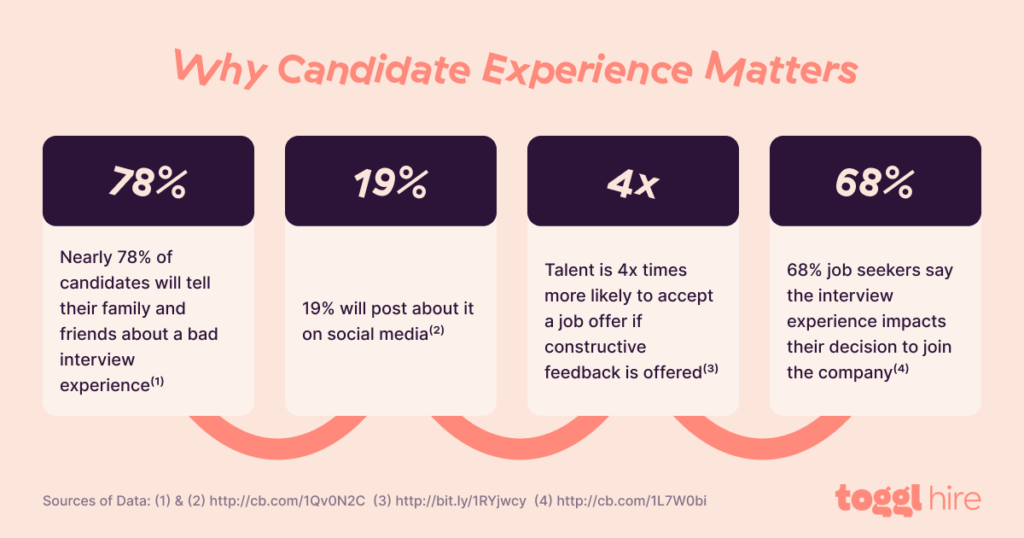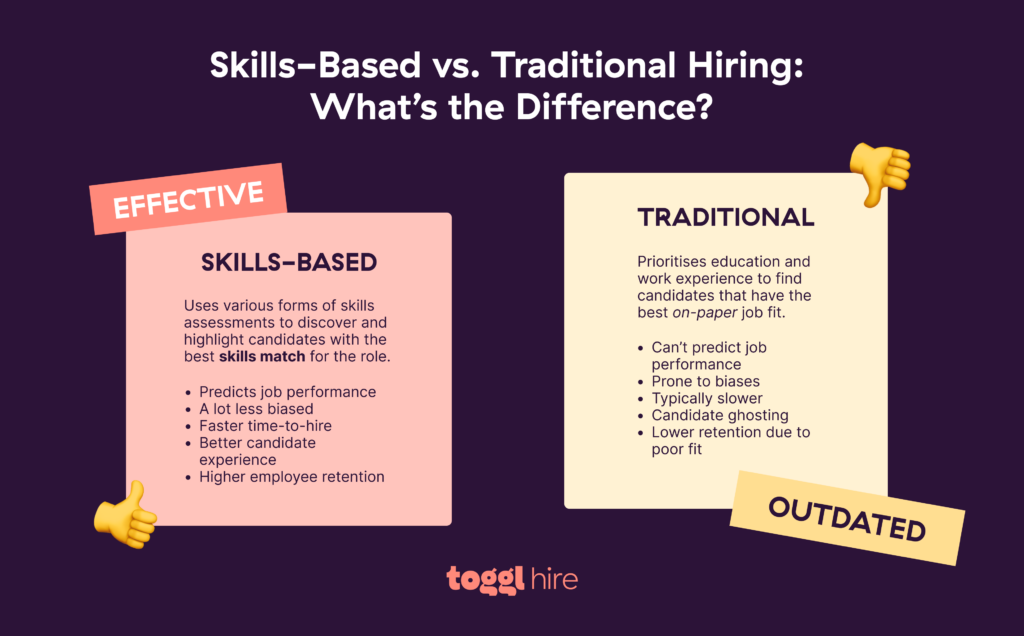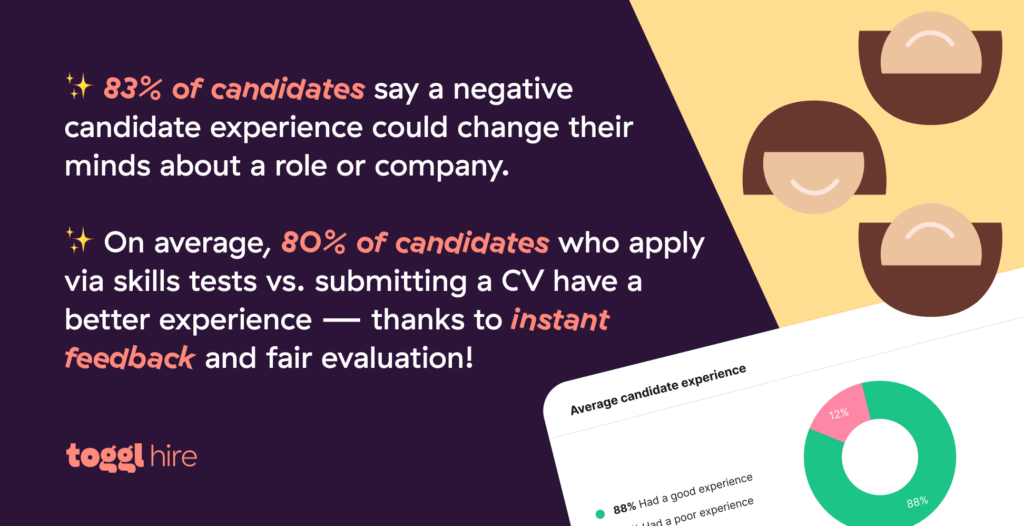Recruiting the right candidate can be an expensive and time-consuming process. At an average cost of $4,700 and a 44-day hiring cycle, there’s little margin for error. But you don’t just have to sit back and accept that you’re part of another recruiting statistic.
With the right recruitment tools and tips, you can slash recruitment costs, reduce downtime, and attract the talent that your business needs. If you want to learn how to improve recruitment process problems, all you have to do is scroll down the page to discover 15 savvy tips from industry experts, from sourcing candidates to creating a killer job posting and more.
TL;DR – Key Takeaways
A bad recruiting process has high costs, and we’re not just talking about financial costs — poor recruiting practices cost companies in terms of productivity, lowered morale, higher turnover, legal and compliance risks, a tarnished employer brand, and so much more.
To improve your recruitment process, start by analyzing and measuring your current recruitment efforts and working on your employer brand and hiring strategy.
Identify your skills gaps and write better job descriptions to accurately fill those gaps. Use skills-based assessments and hiring tools such as Toggl Hire to more effectively assess the hard and soft skills of each candidate.
Re-engage your past candidates, and as new ones pour in, inform them about their progress through email notifications or custom applicant portals (investing in the candidate experience pays off more than you know).

The cost of a bad recruiting process
Improving your recruitment process isn’t just about making things more efficient internally (although we’re sure your hiring team will thank you for investing in optimizing and improving their processes); it can directly impact the company’s bottom line, both internally and externally.
From decreased productivity to a damaged brand reputation, there are numerous factors that contribute to the cost of a bad hiring process.
Hiring costs
As mentioned, the cost of hiring can easily reach at least $4,700 for each bad hire. This includes various costs at every stage of the hiring process, including:
Job board costs
Recruiter/agency costs
Interview expenses
Time spent on onboarding
Moreover, if the candidate hired has inadequate skills (because they’ve been dishonest on their resume and you didn’t properly assess their skills with skills testing), you’ll end up spending even more time and money training them for the role.

Increased employee turnover
A lousy recruitment process can be a nightmare for your company’s employee retention rate and lead to increased employee turnover. Between onboarding and training costs, poor culture fit, and a mismatch in skills, the consequences could be catastrophic. Plus, bad hires spread negativity and even impact overall productivity, so it’s crucial to get the recruitment process right.
Decreased productivity
Hiring the wrong candidate can result in lower efficiency and output, while recruiters who aren’t up to the task can make matters even worse with low recruiter productivity. Hiring employees who don’t fit the company culture or lack the necessary skills can also have a negative ripple effect on overall morale and team synergy — both massive issues that affect productivity across the board.
Lower team morale
Hiring the wrong people can be an absolute disaster for team dynamics, as 70% of US professionals wouldn’t put up with poor workplace culture. Bad hires can lower morale, create tension, and reduce overall performance and employee satisfaction. As a result, employee attrition skyrockets.
Poor employer brand
69% of job seekers would reject a job offer from a company with a bad employer brand, and strong brands attract 50% more qualified applicants. If you don’t take time to improve your recruitment process, you’ll quickly develop a bad reputation, leading to a lack of interest from top talent and difficulties in attracting them in the future.

Missed opportunities
While you’re busy hiring the wrong candidates, the right candidates are also busy — accepting offers from your competitors or other businesses who see their value and quickly onboard them to their teams. What gives? Unfortunately, it’s likely your fault; a poor candidate experience or misaligned job description could have caused them to move to greener pastures.
Legal and compliance risk
Money matters, sure. But a broken hiring process isn’t just expensive; it could also be illegal. When failing to follow fair hiring practices to attract candidates and screen resumes, you could unknowingly fail to comply with local and federal laws and regulations or introduce unconscious bias against potential candidates, which results in decreased quality of hire.
15 tips for how to improve the recruitment process
Currently, about 51% of employees are watching for or actively looking for a new job. And while that may sound grim, it’s also an excellent opportunity for you to find candidates and improve your selection process along the way.
By refining your recruitment process, you can fill your vacant job positions more quickly and attract a great new hire out of the massive talent pool of prospective employees. Just follow these 15 data-backed ways to improve your recruitment process.
1. Understand your current recruiting metrics
You can’t improve what you don’t measure, and in the recruitment and selection process, there are many recruiting metrics to measure, such as:
Cost per hire
Quality of hire
Source of hire
Turnover rate
Offer acceptance rate
And many others
So, start by taking stock of where you’re currently at. Your typical HR tool set will come out of the box with many different metrics to measure by default. However, our recruiting metrics template is a good starting point, too (make a copy of it and customize it to fit your recruitment team’s needs!).
Once you’ve audited your current performance, you can allocate your resources better and measure your hiring efforts even more accurately. As a result, you can make better hiring decisions and find qualified candidates more easily — all at a lower cost.

2. Develop a strong employer brand
As mentioned, 69% of job seekers would reject a job offer from a company with a bad employer brand, and 50% of employees wouldn’t work for a company with a bad reputation, even if they were offered a salary increase.
In many ways, hiring is becoming like marketing, and employer branding is what makes your company stand out from the competition. To improve your employer brand, you can:
Invest time and money in optimizing your careers page
Highlight your employees and their successes on your website and social media
Participate in job fairs and industry events
Monitor your online reviews on websites such as Glassdoor
If you’re unsure where to start, think about your company’s overall mission and vision. You can then determine how you will shape and present your culture to quality candidates.
3. Define your recruitment strategy
A good recruitment process doesn’t happen by accident. You have to create a strategy (and no, “filling open positions” isn’t a strategy, sorry). A great recruitment strategy includes elements such as:
Succession planning
Hiring goals
Ideal candidate profiles
Dedicated sourcing methods
Evaluation criteria
While you can try to incorporate these elements into your interview and screening processes haphazardly, tying them all together in a thought-out strategy allows you to monitor, measure, and optimize your hiring processes in a more organized, efficient manner. If you don’t know how to build a talent strategy, read through our guide.
Start by auditing your current efforts. For example, you might look at your current recruitment channels, whether that’s passive candidates, job boards, social media, your careers page, or an employee referral program, to determine where you’re sourcing the best new candidates.
Then, direct your focus toward improving the process through that channel. To create a structured hiring process from this strategy, think of what roles you need to fill in the future, why you need to fill them, who those people will evolve into, and what the company will look like in two or three years’ time.
4. Identify skills gaps
Don’t just hire to fill a position. Instead, take a look at your existing workforce and hire strategically to fill the skills gaps within your organization. A skills gap analysis helps you determine if you really need to look outward and hire someone new or upskill and cross-skill internally.
Workforce planning is another great way to assess your current employees’ key skills and then forecast your future company needs. Think of the areas where your company may need improvements in the future and hire accordingly.

5. Write better job descriptions
While often overlooked as part of attracting qualified applicants, job descriptions are the bread and butter of talent acquisition. When written well, a great job description can sell even a really bad job in a company that’s falling apart. When written poorly, it can make even the best candidate run away (regardless of how great the job is or how interesting the perks are).
The job description should be clear, accurate, concise, and unique enough to keep candidates engaged. Don’t copy and paste descriptions from online sources or social media (LinkedIn’s full of ’em, we know, but resist the urge!).
Use inclusive language that’s easy to understand, free of jargon, and clearly promotes the main value proposition for the role. From a technical standpoint, try to mention all the right terms that search engines could pick up, too. For example, don’t refer to the position as a “rockstar SDR.” Use a term such as “senior sales representative.”
For more tips on writing great descriptions for an open position, we have a guide full of job description tips and examples.
6. Use skills-based assessments
Skills-based assessments are the ideal tool for the candidate screening process. Instead of sending in a resume or a cover letter, candidates complete a skills test to show off their hard and soft skills. Depending on the role you’re hiring for, talent assessments could include coding tests, SEO skills tests, product management tests, or others.
Skills-based hiring tests have many benefits, including the following:
Lightning fast screening
Reduced bias in hiring
Improved quality of hire
Gives a realistic job preview even before an interview takes place
Improved candidate experience
To align your tests with your job posting and requirements, create an accurate job description first. Then, browse a skills assessment test from the Toggl Hire skills test library, where you’ll find a large database of pre-made (yet customizable) skills tests for various roles.

7. Test for soft skills
While you’re engaging in skills-based hiring as part of reviewing resumes and optimizing your talent pipeline, ensure you’re testing for soft skills alongside those technical skills.
Why are soft skills (which are now called power skills, by the way…the more you know!) so important? One study from LinkedIn revealed that 89% of employers think “bad hires” have poor soft skills.
As AI becomes more prevalent in the workplace, these human-like qualities are going to be a top differentiator for the best candidates. In 2024, some of the most important soft skills to test for include adaptability, critical thinking, leadership, communication, emotional intelligence, and teamwork.

8. Interview for cultural fit
Cultural fit is (often) the missing link that marks the difference between a good candidate and an amazing one. And, unfortunately, you can’t really assess cultural fit by just scanning candidate resumes.
To improve your recruitment efforts in this area, place more emphasis on culture in the hiring process right from the start. Whether on your careers page, website, or social media channels, make it obvious what your culture is all about. Highlight testimonials from current employees to show what the candidate can expect if they join your team.
Then, when job seekers apply to your job listings, screen for culture. You can do this in various ways:
Ask culture-focused questions in the interview process
Conduct panel interviews with employees in the same department
Schedule a paid test week to see how they work with others
At Toggl Hire, we schedule paid test days with all qualified candidates before extending an offer. We spend a day (or sometimes even a week) with the candidate while they perform their typical work. This allows them to get a feel for the daily tasks they encounter on the job, and it allows us to measure their personality, processes, and more.
To accurately gauge cultural fit and improve hire quality, we recommend involving multiple stakeholders in the interview process so you can get diverse perspectives about the candidate’s experience and skills.
9. Re-engage past candidates
Rejecting candidates is an unfortunate but necessary part of the hiring process. However, if you create a rejection letter tactfully, those candidates hopefully won’t get lost in the depths of your applicant tracking system.
Instead, you’ll have created a strong connection with more candidates you can reach back out to if another role opens up in the future. Because you treated them with respect (which is the bare minimum!), they’ll likely be more interested in becoming a new hire this time around. Plus, they already have experience with your talent acquisition process.
Top Tip: If you reject someone for a job role, give them the option to stay on your mailing list and get updates about new roles and company events. An applicant tracking system can help categorize candidates and automate communication so that you don’t drop valuable talent accidentally.
10. Include application progress indicators
Job candidates hate being left in the dark, with Glassdoor reviewers stating ghosting job candidates has increased by 112% since 2020 (yikes). Many companies make it seem like after job applicants hit “submit”, their application goes into the void. We can all do better than that.
To build. amore effective recruitment process, inform candidates each step of the way about their progress. This might look like setting up automated email notifications for the following events:
When a candidate submits their application
When they get the results of their skills test
When they get an invitation to the screening interview
When they’re asked to participate in a test day
You can also introduce a personalized candidate profile, where the candidate can access information about their application upon signing in. The means isn’t as important as the end: maintaining clear and open lines of communication with potential candidates.

11. Make data-driven decisions
Hiring with your gut is akin to going mushroom picking and hoping the one that looks great isn’t poisonous. Plus, in an age where we have more data points than we could possibly handle, hiring based on gut feeling simply makes no sense.
Savvy hiring managers should learn to leverage data from various HR tools to inform their recruitment strategies and refine their processes. For example, let’s say you find out your best candidates come from niche job boards rather than LinkedIn. Great! Now, focus on that channel exclusively.
To develop a more data-driven recruiting funnel, start measuring everything from the initial point of application to the offer. As you start taking note of different hiring metrics, you’ll be able to reduce hiring biases and improve diversity and inclusion in hiring.
12. Attend industry events
Remote work might be the future, but as any good hiring manager knows, you can’t replace face-to-face contact. Check your local and state events or frequent job fairs to see where you could represent your company in the best light possible.
Try to have some of your current employees attend these events — not just your hiring managers. They can most accurately provide qualified candidates with a glimpse into your company culture, values, mission, and vision.
13. Focus on candidate experience
80% of candidates would never reapply to a company that didn’t notify them about their application status. Candidates care about the hiring process for many reasons, but primarily, the way you treat them in the hiring process is a pretty good reflection of the overall culture.
Offering timely feedback to candidates is an excellent way to improve the candidate experience. It also helps to keep the application process short and simple (while still thorough). With tools such as Toggl Hire, it’s easier to let them know quickly if they’re not the right fit and why.
Internally, this might look like pushing recruiting teams to be more organized. Again, with a tool like Toggl Hire, you can view the candidate pipeline, where you’re able to make notes when you interview candidates, assign them tasks, and set auto-reply emails for different recruitment stages.

14. Improve the onboarding process
Did you know that just 12% of employees believe their company has a good onboarding process? That’s a shame, as onboarding is the crucial sequel to hiring. Employees with a positive onboarding experience have a 3x higher commitment to their employers.
To ensure new hires are properly onboarded, try some of the following tips:
Prepare employee onboarding guides with detailed information
Create training materials to help them get up to speed earlier
Give new hires access to key tools and processes ahead of time
Pair them with a mentor during their first weeks to ensure no questions are left unanswered
Schedule regular check-ins to ensure they’re settling into their role
During the onboarding process, schedule regular feedback sessions so you can promptly address any issues that come up. Use the feedback you receive to refine your hiring process in the future.
15. Use the right recruiting software
Recruiting tools can automate the tedious parts of most hiring processes. Hiring managers use them to reduce time spent on screening, skills assessments, interview process, and more.
Use these tools to make your life easier as an HR professional:
Applicant tracking system (ATS)
Candidate relationship management (CRM) tool
Candidate assessment tool
Interview scheduling platforms
Before choosing a tool (or numerous, which we suggest), assess your internal processes. Where are the biggest bottlenecks, and what is causing you to lose great applicants? Once you know what needs fixing, you can take a look at different types of tools and compare their features, scalability, and pricing.
Improve your recruitment process with Toggl Hire
If your recruitment process feels like it’s stuck in the 1990s and job seekers are avoiding you like the plague, think of it as a chance to evaluate your current efforts, find out what you’re doing wrong, and improve it.
As you start to implement a recruitment process improvement plan, introduce skills assessment tests in your workflow. With Toggl Hire, you can improve the candidate experience and the quality of hire while filling positions faster and removing unconscious bias.
It’s not too good to be true — you can have all that and more with Toggl Hire. Get started now for free to see! If you’re not ready to test a new tool just yet, watch this video to see how it works.👇
Mile is a B2B content marketer specializing in HR, martech and data analytics. Ask him about thoughts on reducing hiring bias, the role of AI in modern recruitment, or how to immediately spot red flags in a job ad.










